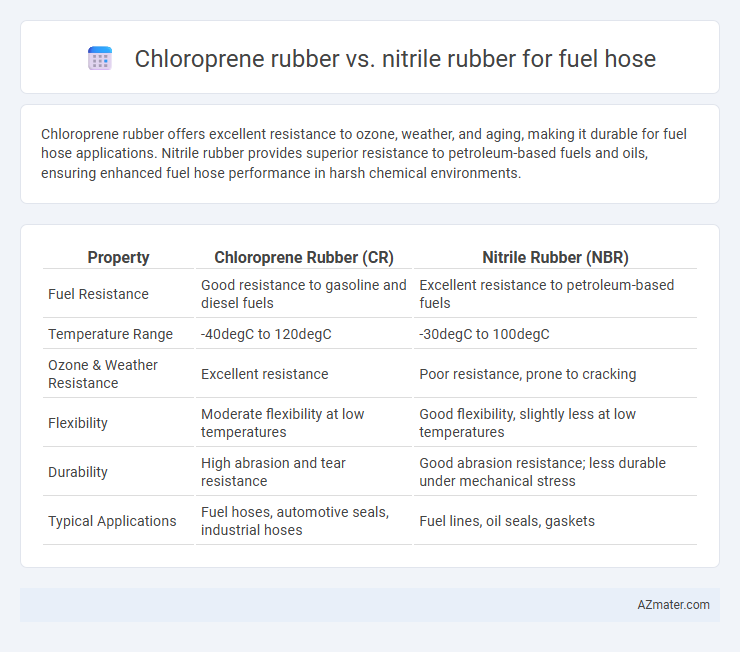Chloroprene rubber offers excellent resistance to ozone, weather, and aging, making it durable for fuel hose applications. Nitrile rubber provides superior resistance to petroleum-based fuels and oils, ensuring enhanced fuel hose performance in harsh chemical environments.
Table of Comparison
| Property | Chloroprene Rubber (CR) | Nitrile Rubber (NBR) |
|---|---|---|
| Fuel Resistance | Good resistance to gasoline and diesel fuels | Excellent resistance to petroleum-based fuels |
| Temperature Range | -40degC to 120degC | -30degC to 100degC |
| Ozone & Weather Resistance | Excellent resistance | Poor resistance, prone to cracking |
| Flexibility | Moderate flexibility at low temperatures | Good flexibility, slightly less at low temperatures |
| Durability | High abrasion and tear resistance | Good abrasion resistance; less durable under mechanical stress |
| Typical Applications | Fuel hoses, automotive seals, industrial hoses | Fuel lines, oil seals, gaskets |
Introduction to Fuel Hose Materials
Chloroprene rubber (CR) and nitrile rubber (NBR) are two prevalent materials used in fuel hose manufacturing due to their excellent resistance to petroleum products. Chloroprene rubber offers superior weather and ozone resistance, making it suitable for outdoor fuel hose applications. Nitrile rubber is highly favored for its exceptional fuel and oil resistance, providing durability and flexibility in environments with constant exposure to hydrocarbons.
Overview of Chloroprene Rubber (CR)
Chloroprene rubber (CR), also known as neoprene, offers excellent resistance to weathering, ozone, and moderate fuel exposure, making it suitable for fuel hoses in less aggressive fuel environments. Its balanced physical properties, including flexibility, tensile strength, and moderate oil resistance, ensure durability and reliability under fluctuating temperatures. Though not as highly fuel resistant as nitrile rubber (NBR), CR is preferred for applications requiring good overall performance and resistance to environmental factors beyond just fuel exposure.
Overview of Nitrile Rubber (NBR)
Nitrile Rubber (NBR) is a synthetic elastomer highly resistant to oils, fuels, and other hydrocarbons, making it ideal for fuel hose applications that demand durability and chemical resistance. Its superior tensile strength and excellent abrasion resistance enhance hose longevity under harsh operating conditions. Compared to Chloroprene Rubber, NBR offers better impermeability to fuels and improved performance in high-temperature environments, ensuring reliable fuel containment and safety.
Chemical Resistance: Chloroprene vs Nitrile
Chloroprene rubber offers excellent resistance to weathering, ozone, and moderate chemical exposure, but Nitrile rubber excels in fuel hose applications due to its superior resistance to petroleum-based oils, fuels, and hydrocarbons. Nitrile's chemical structure provides enhanced barrier properties against aromatic and aliphatic hydrocarbons, making it ideal for long-term contact with gasoline and diesel. Chloroprene may degrade faster in aggressive fuel environments, whereas Nitrile maintains flexibility and durability under continuous chemical stress.
Temperature Performance Comparison
Chloroprene rubber exhibits excellent resistance to temperature variations, functioning effectively within a range of -40degC to 120degC, making it suitable for fuel hoses exposed to moderate thermal conditions. Nitrile rubber outperforms in high-temperature resistance, maintaining integrity from -40degC up to 150degC, which benefits fuel hoses in more extreme thermal environments. The superior heat resistance of nitrile rubber enhances fuel hose durability in engines with elevated operating temperatures compared to chloroprene rubber.
Oil and Fuel Resistance Differences
Chloroprene rubber exhibits moderate oil and fuel resistance, making it suitable for general-purpose fuel hoses exposed to hydrocarbons, but it may degrade faster under prolonged contact with aggressive fuels and oils. Nitrile rubber offers superior resistance to petroleum-based oils, fuels, and hydraulic fluids, maintaining flexibility and strength in harsh environments, which makes it the preferred choice for fuel hoses used in automotive and industrial applications. The molecular structure of nitrile rubber provides enhanced impermeability to oils and fuels, resulting in longer service life and reduced maintenance needs compared to chloroprene rubber.
Mechanical Properties and Flexibility
Chloroprene rubber exhibits superior mechanical properties for fuel hose applications, including high tensile strength and excellent resistance to abrasion, ozone, and weathering. Nitrile rubber offers enhanced flexibility and exceptional resistance to fuels, oils, and solvents, making it ideal for dynamic fuel hose conditions. Both materials balance durability and flexibility, but nitrile rubber generally provides better elongation and resilience under fuel exposure.
Durability and Longevity in Fuel Applications
Chloroprene rubber offers excellent resistance to ozone, weathering, and moderate fuel exposure, making it durable for short to medium-term fuel hose applications. Nitrile rubber, known for superior fuel and oil resistance, exhibits enhanced longevity in harsh hydrocarbon environments, maintaining flexibility and performance over extended periods. For fuel hoses, nitrile rubber typically provides longer service life due to its optimized chemical compatibility with various fuels and oils.
Cost Analysis: Chloroprene vs Nitrile Fuel Hoses
Chloroprene rubber fuel hoses generally exhibit higher material and production costs compared to nitrile rubber due to their superior weather and ozone resistance properties. Nitrile rubber hoses offer a more cost-effective solution, benefiting from lower raw material prices and broader availability, while maintaining strong fuel and oil resistance, making them ideal for most standard fuel hose applications. Evaluating lifecycle costs, chloroprene may justify higher initial investment in harsh environmental conditions, whereas nitrile provides optimal budget performance for routine fuel delivery systems.
Choosing the Right Rubber for Fuel Hoses
Chloroprene rubber offers excellent fuel resistance and flexibility, making it well-suited for fuel hoses exposed to aromatic hydrocarbons and gasoline. Nitrile rubber provides superior resistance to oils, fuels, and chemicals, with enhanced abrasion and heat resistance, ideal for high-performance fuel hose applications. Selecting between chloroprene and nitrile rubber depends on the specific fuel types, operating temperatures, and required durability for optimal hose performance and longevity.

Infographic: Chloroprene rubber vs Nitrile rubber for Fuel hose
 azmater.com
azmater.com